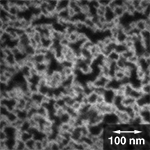Published/Posted: July 21, 2007
Authors: Rossi, A. M.; Wang, L.; Reipa, V.; Murphy, T. E.
DOI: 10.1016/j.bios.2007.06.004
Abstract: There is a growing need for virus sensors with improved sensitivity and dynamic range, for applications including disease diagnosis, pharmaceutical research, agriculture and homeland security. We report here a new method for improving the sensitivity for detection of the bacteriophage virus MS2 using thin films of nanoporous silicon. Porous silicon is an easily fabricated material that has extremely high surface area to volume ratio, making it an ideal platform for surface based sensors. We have developed and evaluated two different methods for covalent bioconjugation of antibodies inside of porous silicon films, and we show that the pore penetration and binding efficiency depend on the wettability of the porous surface. The resulting films were used to selectively capture dye-labeled MS2 viruses from solution, and a viral concentration as low as 2e7 plaque-forming units per mL (pfu/mL) was detectable by measuring the fluorescence from the exposed porous silicon film. The system exhibits sensitivity and dynamic range similar to the Luminex liquid array-based assay while outperforming protein micro-array methods.Citation:
A. M. Rossi, L. Wang, V. Reipa and T. E. Murphy, "Porous silicon biosensor for detection of viruses", Biosens. Bioelectron. 23(741-745 (2007)
Export: BibTeX | RIS
Manuscript: Rossi_Biosens_23_741_2007.pdf
